Whitewashed: how gentrification continues to erase LA’s bold murals
Tensions over disappearing artwork in one of LAs hottest neighborhoods reflect anxiety over rapid change and soaring property prices

Kathy Gallegos remembers the first time she saw John Zender Estradas striking mural of an Aztec warrior flanked by two eagles. She was parking behind a music venue in Highland Park, a heavily Latino working-class neighborhood northeast of downtown Los Angeles, and couldnt help noticing the bold imagery of a piece that Zender had painted in the wake of the 1992 riots to urge ordinary Angelenos to resist violence with peace.
I remember thinking, thats a really nice mural, Gallegos recalled. Next thing I knew, the place was bought and it was gone.
It was the same pattern a couple of years later, when Gallegos who owns a local gallery promoting Latino and Chicano art stopped to admire a graffiti-strewn parking lot wall on the other side of Figueroa Boulevard, where for years young artists had been given free rein to practice and invent at will. She particularly liked a heart image reminiscent of a veteran LA muralist named Frank Romero and made a note to photograph it.
Next thing I know, she said, the whole wall was whitewashed.
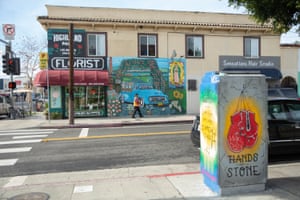
Urban murals are fragile artworks at the best of times, subject to the whims of taggers who may deface them, and of property owners who often want to paint over them or knock down the walls. But Gallegos and many others in Highland Park recognized that these new erasures were different: the result of dizzying change in one of the most rapidly gentrifying parts of LA and, it seemed, a failure by the newcomers to understand the culture of the neighborhood they were starting to call their own.
Now, the consternation that Gallegos and others once felt has degenerated into a full-blown conflict, with the murals of Highland Park acting as a proxy battleground for a variety of other tensions over property prices, the pace of gentrification, tenant evictions, the integrity of once-venerated local artists, and the ability of local city officials to act as honest brokers between the competing interest groups.
Mural wars
Old murals, even those protected under a 2013 citywide ordinance, continue to disappear without warning, triggering noisy protests. Commissioning new artwork, meanwhile, often proves perilous, as muralists endure personal taunts and threats as they paint and never know when their work will get spray-bombed with loud slogans telling the hipsters and gentrifiers to go back where they came from.
The Highland Park mural war erupted in earnest in 2017, when two city-owned sites including the wall with the Frank Romero-esque heart were whitewashed, and a radical group calling itself Restorative Justice for the Arts started accusing local city officials of colluding with incoming property speculators to destroy the neighborhood.
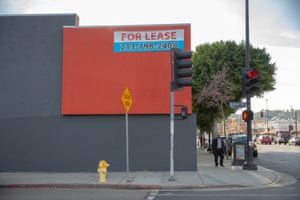
It did not help the citys cause that a trail of official emails soon became public and showed that council employees had deemed the long-standing graffiti walls to be illegal and given their blessing to a local business owners association to wipe them clean.
The city appeared to understand it had made a blunder and sought to make amends by asking Zender, the artist behind the destroyed Aztec warrior, to paint something new at the site of one of the erasures. The plan fell apart, though, after Zender complained that the offer came with too little money and too many conditions about who in the neighborhood Zender was allowed to associate with.
Plan B was to turn to the venerable Frank Romero most famous for a mural he painted on the side of a downtown freeway for the 1984 Los Angeles Olympics who accepted the commission but passed most of the work off to an assistant, since he lived most of the year outside the United States.
The new mural was attacked over and over, once with blue paint and the single word Displacers (in imitation of the Dodgers baseball teams logo), and another time with crude white spray paint that read: Fuck hipsters. The anti-gentrification activists were incensed, first because a local real estate agency was sponsoring the mural, which made Romero a sellout in their eyes, and second because Romeros assistant was white. Pretty soon the wall was back to all white, too.
Next on the anti-gentrification taggers list was a mural on the side of an upscale bar and deli called Tinfoil (since renamed Flask), where whisky connoisseurs can spend as much as $1,200 on a single bottle. The city itself vetoed Tinfoils first idea, which was to turn the mural into an advertisement for Johnny Walker. Instead, the bar commissioned a local Latino artist, Sol Luongo, to produce a montage of Highland Park landmarks under the title Momentos Magicos Magic Moments.
One of the features Luongo included was a piece of vernacular art that a graphic designer brought into the neighborhood just a few years ago: a giant statue of a man with a chicken head and a bucket of wings that once adorned a restaurant roof in downtown Los Angeles and now sits on its owners roof on Figueroa Boulevard. It has proven a powerful marketing tool for the local business association which is exactly why the anti-gentrification crowd hates it.
Were not going to allow Chicken Boy to become the statue of Highland Park. It has nothing to do with Highland Park. Thats some Christopher Columbus shit, said Brenda Perez, founder of Restorative Justice for the Arts.
The mural was tagged repeatedly as it went up, and Luongo became so afraid of one particular activist who hurled abuse at her from the sidewalk that she asked friends to stand by her while she worked. Her mural did get completed, and the bar paid to have it coated in an expensive graffiti-resistant varnish. But it continues to be attacked regularly enough for the bar manager to have the city graffiti-cleaning service on his speed-dial.
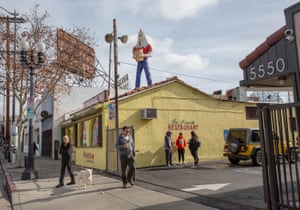
Erasing history
Many Highland Park residents and business owners claim the anti-gentrification taggers and protesters are a tiny minority who do not represent the views of a diverse and broadly happy community. On the other hand, many of those same residents and business owners have been shocked by the aggressiveness of property speculators who have bought out apartment buildings and storefronts and either jacked up the rents sometimes more than threefold overnight or evicted the tenants on short notice.
Some of Highland Parks most revered muralists have themselves been priced out of the neighborhood. And there is a sense, among those who grew up with them in the 1990s and 2000s and are still hanging on either because they own their own houses or continue to live in rent-controlled apartment buildings that whats at stake is an essential piece of the citys soul. Those of us born and raised in LA know the significance of murals, and those who arent from here dont know, said Irene Narvaez, the principal of Highland Park High School who grew up locally and now encourages student mural-painting on her own schoolyard. Theres more about social justice and history in these murals than my students can learn about in books.
Its not that the newcomers are hostile to mural art, because most of them arent. And while Perez and her allies point fingers at the city, the city says, with some justification, that it has only limited enforcement authority. You have to have a culturally sensitive approach, but theres also a whole issue related to property ownership, Conrado Terrazas of the local council district office said. Its very complicated.
Often, the problem is not ruthless property speculation, but a glaring lack of sensitivity among those, including public officials, who should know better. Last October during National Hispanic Heritage Month no less a Highland Park elementary school principal who did not grow up in the area whitewashed a much-loved mural depicting immigrant farmworkers, ostensibly because she was worried that it was attracting graffiti.
After the principal felt the communitys outrage including a letter from the son of Cesar Chavez, the legendary Californian farmworkers leader she contacted the original artist and a second muralist and began planning for a replacement. What remains unclear, however, is whether she wants to restore the spirit of the original or as the artist, Daniel Cervantes, told the Guardian she wants to use the mural to promote Garvanza Elementary as a magnet school. (The principal, Sarah Gilman, would not comment beyond a brief statement saying how excited she was to move forward with community input.)
First they push people out, and now they want to erase the history of the walls we wanted to put up, Cervantes said. I want to keep the peace and try to make it right, but we have got to have an explanation. Weve lost so much and have very little left.
Cervantes, who moved to the outer suburbs three years ago to raise his daughters and earns his living mostly as a tattoo artist, has gone through a similar agony over what is arguably his masterwork a 170-ft frieze depicting indigenous peoples and myths from Canada down to Mexico that adorns the roadside perimeter of the Southwest Museum of the American Indian in LA.
For several years after he completed the mural in 2004, the museum took good care of it. But starting in 2013, Cervantes said, the museum started ignoring his maintenance recommendations, the paint was soon covered in graffiti, and eventually the whole thing was whitewashed. A consortium of interested parties including Kathy Gallegoss Avenue 50 Studio and the city raised $20,000 to have it restored but somehow cut Cervantes out of their deliberations and ended up giving the job to another artist.
The mural looks stunning once more the restoration is expected to be completed by early February but there is no budget to maintain it and the museum property is up for sale, which could leave the mural without institutional support. Cervantes is fatalistic about a piece that has broken his heart many times already. Que sera, sera, he said.
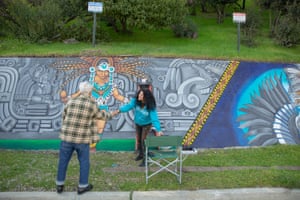
We need to preserve them
There was a time, more than a decade ago, when the political leadership in Los Angeles pushed hard to preserve the mural art that, in many ways, has defined the popular culture of the city. Zender recalled how Ed Reyes, the city council member for Highland Park from 2001 to 2013, would not only visit his work sites but would dip a brush in the paint himself. Antonio Villaraigosa was a council member in the neighboring district from 2003 to 2005 and then LA mayor for the next eight years; he, too, was a champion of the muralists and helped create a register to preserve their work.
What has changed since is not so much the political outlook of the new leadership than the sheer pace of change as LAs economy has boomed and waves of young professionals have radiated out from downtown and Hollywood (themselves once depressed) into the next ring of neighborhoods. The rules protecting murals were never that strong to begin with, but in the swirl of gentrification they have often been overlooked or forgotten.
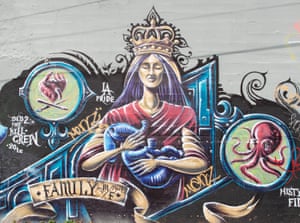
Things can go out of whack when people dont follow protocol, Zender said. What happened to the Aztec warrior mural is that people didnt follow protocol.
Now the protocol is about to be tested again with what is arguably Zenders masterwork another big piece, painted with nine other muralists, that runs along the side of a commercial building on North Avenue 61 titled Tenochtitlan the Wall That Talks, after the great Aztec city destroyed to make way for Mexico City. A consortium led by a Beverly Hills property developer bought the building last August, just as Zender and some of the other artists were putting the finishing touches to a comprehensive restoration. Now the owners have told Zender through an intermediary that they intend to install two windows along that wall.
Theoretically, the piece is protected, but it is far from clear that the city or anybody else has the power to stop the new owners from punching holes through the existing artwork. Zender said that if the choice was to cooperate with the owners to modify Tenochtitlan or to risk losing it altogether, hed opt for what he called the lesser evil.
The community, meanwhile, is awash with rumors of what exactly the owners intend. Restorative Justice for the Arts is organizing a blessing for the mural with native healers and Aztec dancers this Sunday. And Terrazas of the council district office was, for once, in sympathy with them. We want to preserve that mural, he said. We need to find a way to make that happen. He was skeptical that any plan to install windows would pass muster with the citys Department of Cultural Affairs.
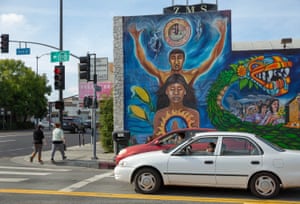
The owners identifying themselves only by the name of their limited company, Fig Crossing LLC, and communicating only via their lawyer appear to have been stunned by the vehemence of the reaction to their plans. Many reporters thrive on writing sensational articles that portray evil developers who are destroying the community, but that is not what you have here, the lawyer, Skip Kessler, insisted in an email to the Guardian. He did not, however, deny that the plan was to punch window holes in the mural.
Kathy Gallegos, the art gallery owner, said she saw Highland Park as part of a sad pattern across Los Angeles Latino communities where street art has often given way to commerce and a city-wide tendency to forget its own history. In other countries they have more respect than we do here in LA, she said. We have to get into peoples minds that murals are monuments. They are historical and we have to preserve them.
We were the mural capital of the world. And were not any more.
